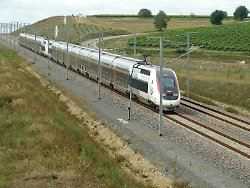Wednesday, September 22, 2021
Billions for new routes
France is proud of its railways
France has been shrinking for 40 years. The distance between the metropolises seems to be decreasing since the TGV rushes through the country. In contrast to neighboring Germany, Paris has relied on separate routes from the start and thus enables high speeds. Germany takes years to catch up.
At a time when the motorway network was growing and the railroad was slowing down, the start of the TGV in France 40 years ago was a revolution Lyon took up, the cities around 470 kilometers away moved closer to each other with a driving time of 2 hours and 40 minutes. They are now only separated from each other for two hours. The flight connection became superfluous. In Germany, the Intercity had already started ten years earlier on September 26, 1971, with modern trains connecting major cities for the first time every two hours.
The problem with the railways was the same in both countries: In the post-war years, cars became affordable for everyone, expressways made more and more regions quickly accessible, while steam locomotives puffed in front of a number of trains for a long time. It is true that the railways used the Trans-Europ-Express (TEE) to send modern new trains between Europe’s metropolises onto the track. However, these only had first-class cars and were hardly an alternative to the new freedom of their own cars for the general public. The Intercity, which often replaced the classic express train, initially only had 1st class cars and was not for people on a tight budget.
Tempo 300 and more
The new streamlined electric locomotives that were purchased for the Intercitys, however, quickly became the new flagship of the former Federal Railroad and gave it a modern image. From 1979 onwards, the Intercity network was called “every hour, every class”: from then on, the trains also carried second-class cars and connected major West German cities every hour with fixed transfer options. Meanwhile, Berlin had to wait for the IC connection until the fall of the Berlin Wall.
In the meantime, the TGV became the flagship of France’s innovative strength and was seen as a model for neighboring countries to build their own high-speed lines. Because with the construction of separate, new railway lines for the fast trains, France was also ahead of Germany. While Tempo 200 was initially only reached on some sections of existing routes, the French are relying on new routes for Tempo 300 and more for their growing TGV network.
It was not until 1991 that a high-speed train started in Germany with the ICE, for which the first two new routes Hanover-Würzburg and Mannheim-Stuttgart were created. While France fully relied on the expansion of the TGV network with a length of now 2700 kilometers and 180 connected cities, Germany was still discussing the construction of the Transrapid maglev train for decades, with speeds of up to 500 km / h it would have been even faster. First a line was to be built between Düsseldorf and Cologne / Bonn airports, then from Berlin to Hamburg, Düsseldorf to Dortmund and finally to Munich airport, and in 2008 Germany buried the technology.
France continues to expand the TGV network
France meanwhile has big plans with the TGV even after the milestone anniversary. At the 40th celebration in Paris’ Gare de Lyon on, President Emmanuel Macron presented the future TGV M. It will be used from 2023, will be more accessible, digitally networked and, on top of that, more ecological, the head of state praised it. France wants to invest 6.5 billion euros in the construction of further high-speed lines so that the parts of the country move closer together and all French can travel CO2-free. Toulouse, Perpignan and Nice in southern France as well as Normandy are to be connected, and a line from Lyon to Turin in Italy is also being planned.
As far as the length of the fast routes is concerned, Germany can now stand up to France: on 2700 kilometers, at least 200 km / h is possible, on 1000 kilometers, 250 or more is driven. This high-speed network should grow by another 50 percent in the coming years, announced the DB. It is about the routes from Hanover to Hamburg and Bielefeld, as well as from Fulda to Frankfurt. A high-speed route is also being planned from Dresden to Prague. Making short-haul flights superfluous and traveling in a climate-friendly way are arguments for the expansion. “We are consistently expanding cross-border high-speed traffic together with our partner railways in Europe,” said DB long-distance transport manager Michael Peterson.
To this end, DB is investing with the other railways in vehicles that can be used internationally. “For example, new, 230 km / h trains between Berlin and Amsterdam will be used in the 2024 timetable, which will shorten the journey time between the two cities by around 30 minutes.” And the Intercity, which has long since become the little brother of the ICE from its flagship, will also be used on other lines in the future. After the new IC line Dresden-Berlin-Rostock started in 2019, the connection from Frankfurt / Main via Siegen to Münster will follow in December with individual trips to Norddeich.
